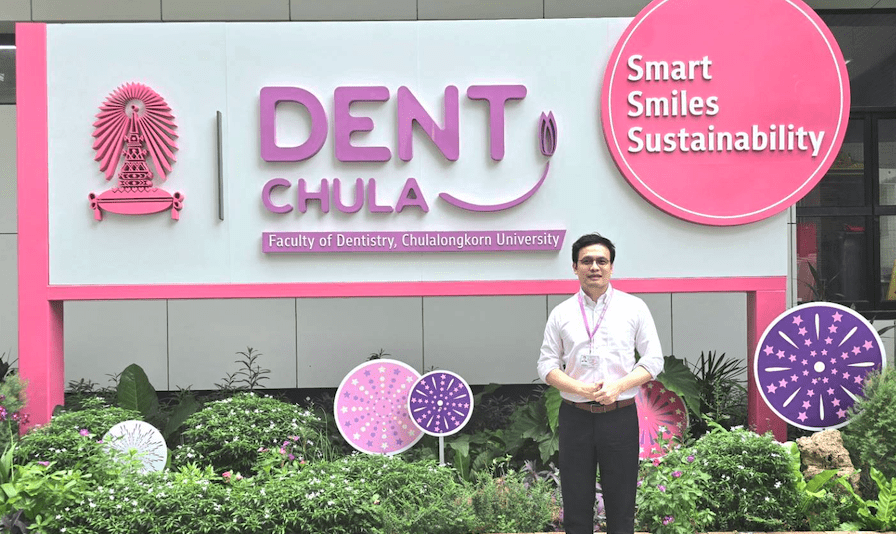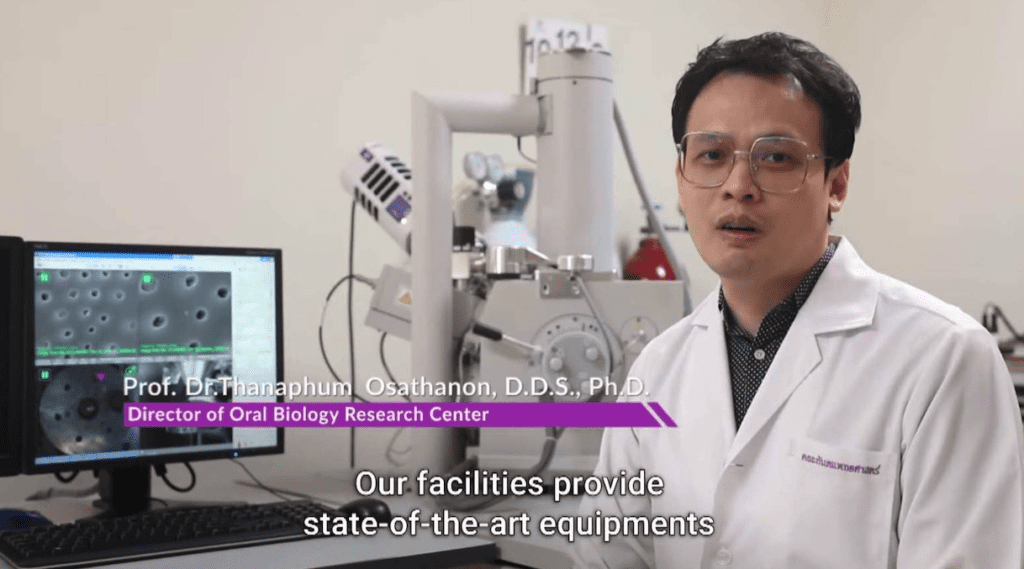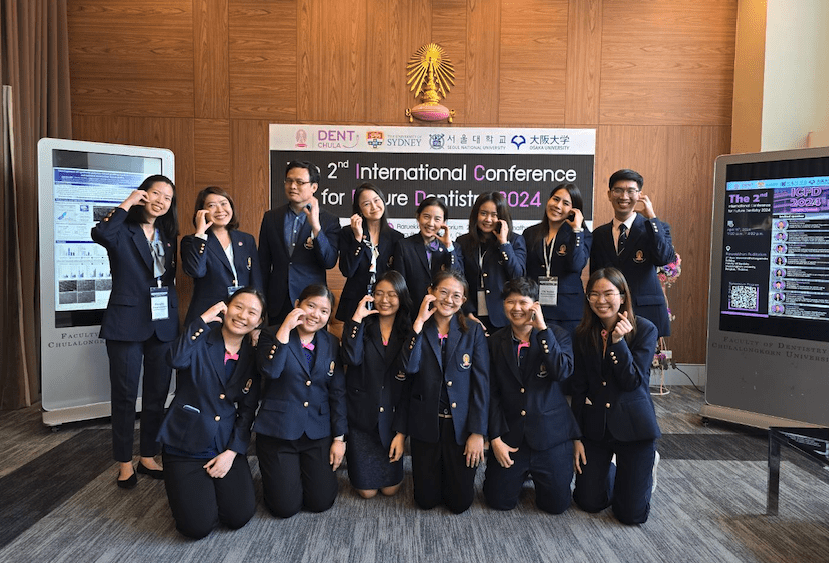Groundbreaking research at Bangkok’s top dental faculty unveils the regenerative potential of dental pulp stem cells, paving the way for revolutionary treatments in oral health care worldwide.
By Danny Chan
Amidst the vibrant mix of chaotic traffic, lively street markets, towering skyscrapers, and bustling crowds of Bangkok, a quiet revolution is reshaping the landscape of dental science. Chulalongkorn University’s Center of Excellence in Dental Stem Cell Biology Research stands at the nexus of this transformation, challenging the boundaries of dental care. In this exclusive report, we uncover the groundbreaking work that’s propelling Thailand onto the global stage of dental innovation.
Rise of a Dental Powerhouse
Just as the streets of Bangkok pulse with life, a stream of energy courses through the halls of Chulalongkorn University’s Faculty of Dentistry. Here, in state-of-the-art laboratories, researchers are unlocking the secrets of dental stem cells, their work resonating far beyond the borders of Thailand.
The faculty’s recent ascent into the top 70 dental schools worldwide, according to the QS World University Rankings by Subject 2023, is no mere coincidence. It’s the culmination of years of dedicated research, innovative thinking, and a commitment to excellence that permeates every aspect of their work.

Associate Professor Dr. Thanaphum Osathanon, Deputy Dean for Research at the Faculty of Dentistry, provides insight into this remarkable journey. “Throughout the past, we have promoted faculty members to develop research and academics,” he explains. “There are grants for new researchers supported by the faculty and the university. We have workshops for writing research articles with senior researchers as mentors.”
This commitment to nurturing talent extends far beyond research papers and lab work. The faculty has cultivated an ecosystem where innovation thrives, blending cutting-edge research with comprehensive education programs. Dr. Thanaphum elaborates on their diverse curriculum: “We have various kinds of approaches for stem cell research, but basically focus on oral stem cells. In our school, the research focus ranges from basic side research like studying properties of stem cells isolated from oral cavity, to the idea of using stem cells for regeneration approaches by transferring stem cells back to the body.”

Pioneering Dental Stem Cell Research
One of the center’s groundbreaking projects is focused on dental pulp stem cells. Dr. Thanaphum’s eyes light up as he shares the details: “We mainly focus on the stem cells of dental pulp. The tissue inside the tooth can make dentine. When you have an injured tooth structure, for example, dental caries or infections of the dentine, normally the body is going to make what we call regenerative reparative dentine.”
This research isn’t confined to theoretical musings; it has far-reaching implications for millions worldwide. By understanding and harnessing the regenerative power of dental pulp stem cells, the team at Chulalongkorn University is paving the way for revolutionary treatments for dental injuries and diseases.
The center is also hard at work developing bioactive materials to enhance stem cell differentiation.
“We try to enhance those materials by putting bioactive molecules in them,” Dr. Thanaphum explains the approach.
“Hopefully, when we apply that material with bioactive molecules into the exposure site of that pulp tissue, it can have more efficacy to promote dentin formation in that particular area.”
This fusion of stem cell research and material science exemplifies the interdisciplinary nature of the work being done at Chulalongkorn.
It’s not just about understanding stem cells, Dr. Thanaphum stresses: “It’s about creating practical applications that could transform dental treatments, making them more effective and less invasive.”

From Lab to Literature
The impact of Chulalongkorn’s dental research extends far beyond the confines of their laboratories. Their commitment to scientific dissemination is evident in their impressive publication record in high-impact, peer-reviewed journals.
Dr. Thanaphum modestly notes, “Mostly, I published only in the basic science side, meaning how we manipulate the cells in the lab and how the cells respond to those immobilization things.” But this understates the significance of their contributions to the field.
Their research has graced the pages of prestigious journals such as Scientific Reports, a part of the Nature publishing group. One notable study, titled “Indirect immobilized Jagged1 suppresses cell cycle progression and induces odonto/osteogenic differentiation in human dental pulp cells,” provided crucial insights into the mechanisms of dental pulp cell differentiation.
This groundbreaking work demonstrated that indirect immobilized Jagged1, a protein involved in cell signaling, could effectively activate Notch signaling in human dental pulp cells. The implications of this research extend beyond the realm of basic science, offering potential avenues for new therapeutic approaches in dental regeneration.
Another significant publication, appearing in the Journal of Biomaterials Applications, showcased the team’s innovative work on developing novel biomaterials for dental regeneration. The study, “Preparation and characterization of Jagged1-bound fibrinogen-based microspheres and their cytotoxicity against human dental pulp cells,” highlighted the potential of these microspheres as a delivery system for promoting odontogenic differentiation.
These publications not only demonstrate the center’s scientific prowess but also contribute to the global body of knowledge in dental stem cell biology.
As Dr. Thanaphum reflects, “When we publish it, there’s a lot of talking about, like, let’s say citations, or even using that type of technique globally. So I think that also contributes something to intangible assets. You cannot measure it, but it has some value academically worldwide.”
<< Back to Contents Menu
EDITOR’S PAGE | ADVISORY BOARD | NEWS | PRODUCTS | COVER FEATURE | CLINICAL | PROFILE | EXHIBITIONS & CONFERENCES | PRACTICE MANAGEMENT

The Path to Clinical Application
The journey from laboratory breakthrough to clinical application is fraught with challenges, a reality that Dr. Thanaphum and his team face head-on. “To develop a bioactive for use in clinic, it takes several steps,” he explains. “It’s not like making materials for clinical use because we’re adding something bioactive into those materials. The regulation is different from material itself. So it has more investigation, more efficacy and safety need to be actual in animal first, before we further test in human and then elaborate into commercial market.”
The professor’s candid acknowledgment of the hurdles also speaks to the integrity and rigor of their research process. The path to clinical application is long and winding, requiring scientific acumen, perseverance and team management skills.
Dr. Thanaphum’s approach to leadership shines through as he describes the challenges of maintaining team morale: “The challenging thing is trying to keep the team’s spirits high and focused on contributing something tangible towards the future of dentistry. After experiencing multiple failed attempts – which is the nature of conducting research tests – you want them to continue believing in the project and thinking long-term. Otherwise, it’s easy to succumb to negativity and affect the team morale. So I think encouraging the team to continue striving towards the original goal, while thinking of new approaches to meet the prevailing challenges, would be the most challenging thing as a leader.”
AI, Robotics, and Beyond
As the field of dentistry evolves, so too does the focus of the Center of Excellence. Other potential areas of dental research include artificial intelligence and robotics.
Dr. Thanaphum’s vision for the future is both exciting and pragmatic: “AI is going to be very active, robotic and digital dentistry are going to be very popular. Even in complex treatment like implants, they are thinking about robotic implantations already. I think it’s going to come soon.”
This forward-thinking approach is mirrored in the establishment of the Chulalongkorn University Dental Innovation Center. Dr. Thanaphum, who serves as the Deputy Director of the center, explains its role: “We foresee that it’s going to be very useful. I mean, we accept technology from outside, but we never generate ourselves in Thailand. So if we can encourage staff and students to come up with some ideas, just ideas, not even products or services yet, just come up with ideas that we can incubate and help them to make that idea happen, I think it can be at least useful, or maybe change the mindset of dentists, not just only treatment, but also innovate as well.”
This innovation hub has already seen success stories, such as the development of Dent Cloud, a cloud-based dental clinic management system now used by thousands of clinics across Thailand. It’s a testament to how research and innovation at Chulalongkorn are having real-world impacts beyond the realm of stem cells.

A Dream of Clinical Impact
Despite the cutting-edge nature of their research and the exciting possibilities of AI and robotics, Dr. Thanaphum and his team never lose sight of their ultimate goal. “It’s still my dream that I want to push it to clinical application,” he shares. “Right now we have some successful stories from laboratory side and animal side. And now we try to prove that idea can be used in clinic or even commercialized in the future, if it’s possible. If it’s something that we do that’s really useful for patients, that would be my greatest happiness.”
Students at the Faculty of Dentistry have access to state-of-the-art facilities and are encouraged to participate in cutting-edge research projects. This hands-on experience, combined with mentorship from leading researchers like Dr. Thanaphum, is creating a new generation of dental scientists ready to tackle the challenges of tomorrow.
The faculty’s rise in global rankings is more than just a number; it reflects a holistic approach to dental education and research. By balancing teaching, research, and patient care, Chulalongkorn’s Faculty of Dentistry is setting a new standard for dental education in the region.
Nurturing The Next Generation of Dental Scientists
Through their groundbreaking work in dental stem cell research, development of bioactive materials, embrace of new technologies, and commitment to education, the Chulalongkorn University’s Center of Excellence in Dental Stem Cell Biology Research’s commitment isn’t just to advancing dental science but potentially transforming patient care on a global scale.
As they continue to push the boundaries of what’s possible in dental research, navigating the challenges of translating laboratory successes into clinical applications, the center stands as a shining example of how dedication, innovation, and a commitment to excellence can put a nation at the forefront of a scientific field.
The future of dental care looks brighter thanks to the pioneering work being done in the heart of Bangkok. And as Dr. Thanaphum and his team continue their relentless pursuit of knowledge and innovation, one can’t help but feel that we’re witnessing the early stages of a dental revolution that will benefit millions around the world.
The smile of the future is perhaps being crafted today, in the laboratories of Chulalongkorn University.
The information and viewpoints presented in the above news piece or article do not necessarily reflect the official stance or policy of Dental Resource Asia or the DRA Journal. While we strive to ensure the accuracy of our content, Dental Resource Asia (DRA) or DRA Journal cannot guarantee the constant correctness, comprehensiveness, or timeliness of all the information contained within this website or journal.
Please be aware that all product details, product specifications, and data on this website or journal may be modified without prior notice in order to enhance reliability, functionality, design, or for other reasons.
The content contributed by our bloggers or authors represents their personal opinions and is not intended to defame or discredit any religion, ethnic group, club, organisation, company, individual, or any entity or individual.

